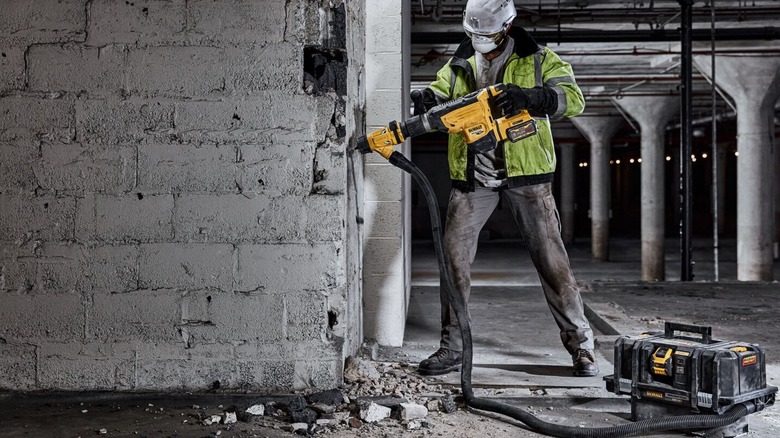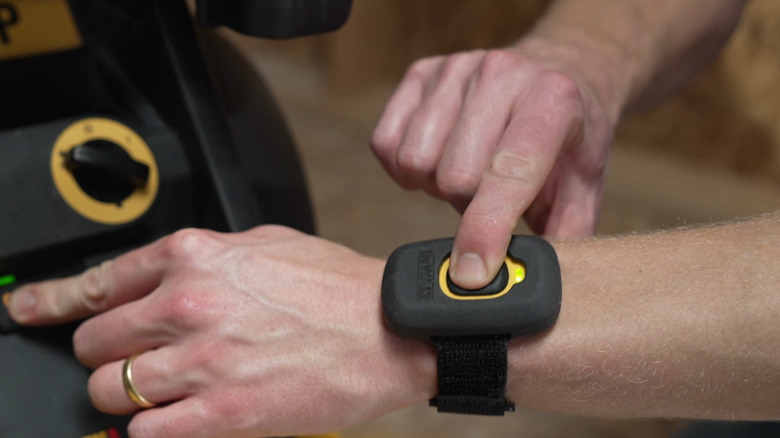How Does DeWalt's Wireless Tool Control System Work?
For the combined purposes of safety and productivity, it's good to keep your tools functioning as a single, cohesive unit. You don't want to be operating a heavy-duty device like a miter saw, for example, and have to walk all the way over to the other side of your workshop to turn on the dust extractor or shop vac every time. It's an annoying little burden, and you definitely don't want to have to leave any equipment running while you're walking around to push buttons. Of course, also for safety purposes, these kinds of tools are only designed to function when the trigger is held, so you might not have a choice in the matter.
To address this particular grievance, DeWalt has developed the Wireless Tool Control System, a quick means of networking your tools and utilities together to synchronize operation and improve your overall workflow. This particular system is different from DeWalt's Tool Connect feature, which is meant to assist with tracking and cataloging tools and accessories. Wireless Tool Control directly links the activation switches on your tools, or at least links one of them to a convenient, wrist-mounted remote if the other doesn't have the required tech.
Wireless Tool Control lets you activate one tool by activating another
Wireless Tool Control is a feature present within certain subsets of DeWalt tools and products, particularly those involved in concrete work, carpentry, and dust management. These include miter saws, concrete vibrators, dust extractors, angle grinders, core drills, and others. You can identify a tool or utility with Wireless Tool Control functionality by locating the little chain link symbol on its body, usually near the trigger or activation switch.
To pair two tools with Wireless Tool Control functionality together, find the rocker switch with that chain link icon on the receiving tool and turn it on. A small LED light should start flashing, indicating that the tool is in pairing mode. On the transmitting tool, either squeeze the trigger or activate the dedicated chain link switch to make a connection. The LED on the receiving tool should switch from flashing to solid light when a link has been established.
When the link is set up, squeezing the trigger on the transmitting tool will automatically activate the receiving tool at the same time. For example, if you've linked one of DeWalt's miter saws to a dust extractor, the dust extractor will automatically power up while you're running the miter saw, catching any sawdust you produce while working. Just remember that this system uses direct radio waves rather than Bluetooth or Wi-Fi, so the tools must have line of sight and be no more than 30 feet apart.
There's a standalone remote if one tool can't link up
While the Wireless Tool Control feature is convenient for optimizing your workflow, only a small subset of DeWalt products are equipped with it, around 26 products in total based on DeWalt's website. Unfortunately, if only one of the tools you're using has Wireless Tool Control, it won't be able to pair with the other. Luckily, there is a way to activate the feature even if only one tool has it: the dedicated DeWalt wireless remote.
The wireless remote has a button for tools and utilities with Wireless Tool Control. To use it, just press the chain link button on the receiving tool as usual, then press the button on the wireless remote. The tool will be paired with the remote, allowing you to activate or deactivate it by pressing the button again. Even if you're across the room, you can tap the button on the remote to activate your dust extractor and keep things clean while you work. You can secure the remote to your wrist using the included hook and loop band.


